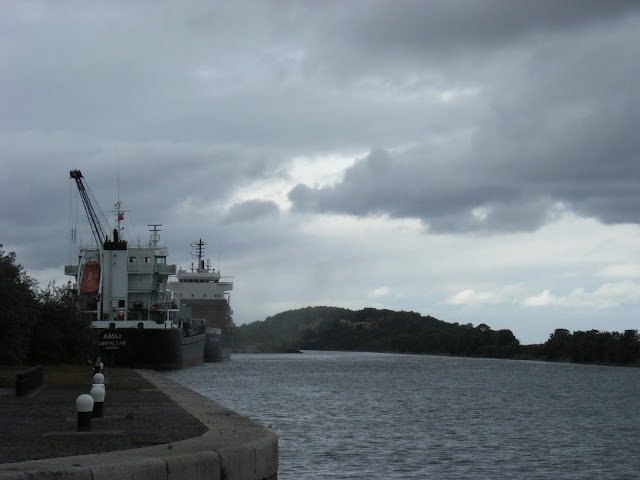We got to Ellesmere Port about 1200. We set off a little earlier as the morning was set to be fair. We got to the National Waterways Museum entrance and there was no where to moor to make inquiries as there was a load of folk with radio controlled model tugs. There were people around in the museum dressed in Victorian costume and the sound of barrel organs playing. In the end we winded and found somewhere close by. There was plenty of rubbish about and the moorings had several very shallow bits. Not exactly very inviting. We walked into the old Ellesmere Port centre to by a paper. It was through an underpass under several roads and a motorway!
After lunch we walked back to the Museum and paid our £7 entrance each. Ellesmere Port was actually a port that was created at a village called Netherpool. The original canal was built through to Chester and goods were transhipped from the river. It wasn't until the canal at Chester was connected with the rest of the system when Shropshire Union canal was pushed through to Chester and then it boomed. It received another boom when the Manchester Ship Canal was built and also connected. The museum is really about the Port rather than the canals and it is great that it was preserved. It holds a collection of narrow and wide craft in various states of preservation and is a centre for heritage crafts to restore them. I would have paid the entrance fee for the videos of the Manchester Ship Canal as it took me right back to when I started at sea and sailed on ships just like those pictured. The work in the ports was also almost the same too, pre-containerisation.
After lunch we walked back to the Museum and paid our £7 entrance each. Ellesmere Port was actually a port that was created at a village called Netherpool. The original canal was built through to Chester and goods were transhipped from the river. It wasn't until the canal at Chester was connected with the rest of the system when Shropshire Union canal was pushed through to Chester and then it boomed. It received another boom when the Manchester Ship Canal was built and also connected. The museum is really about the Port rather than the canals and it is great that it was preserved. It holds a collection of narrow and wide craft in various states of preservation and is a centre for heritage crafts to restore them. I would have paid the entrance fee for the videos of the Manchester Ship Canal as it took me right back to when I started at sea and sailed on ships just like those pictured. The work in the ports was also almost the same too, pre-containerisation.
Modern Ellesmere Port on the Manchester Ship Canal with vessels working on a Sunday!
Narrow and wide locks from the Upper Basin to the Lower Basin. To the right there used to be a covered warehouse where goods were passed from one level to the other or stored.
'Cuddington'. This one of the last of the Brunner Fleet that worked on the River Weaver for ICI. She was built in 1948 and carried 300t of cargo on the Weaver and Mersey. She was bought by the Museum in 1981 for £1.
'Cuddington' in the background and Basuti in the foreground. Basuto was built in 1902 in Glasgow and is a Clyde puffer. She had a varied career and latterly was working on the Manchester Ship Canal for a ship repair company to take tools and equipment to vessels in the docks requiring their services. She could carry 80t.
'Mossdale' is a wooden Mersey Flat that was built about 1860. She was oak framed with pitch pine planking. She worked on the Mersey and Manchester ship canal carrying all sorts of cargoes. She could carry 54t of general cargo or 70t of bulk at a draft of 4'6". She was bought by the Museum in 1978 and has undergone a fair bit of preservation.
On the left is the narrow boat Gifford. She was built in 1926 and was a specialised carrier of gas tar from gas works to refiners. She carried about 25t in tanks below dock. She latter carried fuel from Ellesmere Port refineries to the Midlands. She was built in Braunston for Thomas Clayton. She had a baby born aboard here and a 13 year old die in her fore cabin being overcome by fumes from the stove. She worked up until 1963 and finally came to the museum being one of the first of the collection in 1976.
The Dock was almost self sufficient and there is even a row of original workers cottages which are set up in eras through out their life. There is a big blacksmiths shop and the machinery of the port was run by hydraulics that were all in house. It was a fascinating few hours and interesting to see the various exhibits too. It is a longtime since I have been here, or the Museums at Gloucester and Stoke Bruerne and it will be interesting to compare them all.






2 comments:
This was the place we came to last Easter with Will and Abi. We had a good few hours here too and thought it was really interesting with lots of fascinating facts/history.Glad you had a good time here. Heather
Hi There, It was a good way to spend a few hours and as I said it was nice to see the old films of the ships on the Manchester Ship Canal. Hope the Abi is doing well with the run up to her finals. Cheers fro now, Tony and Helen.
Post a Comment